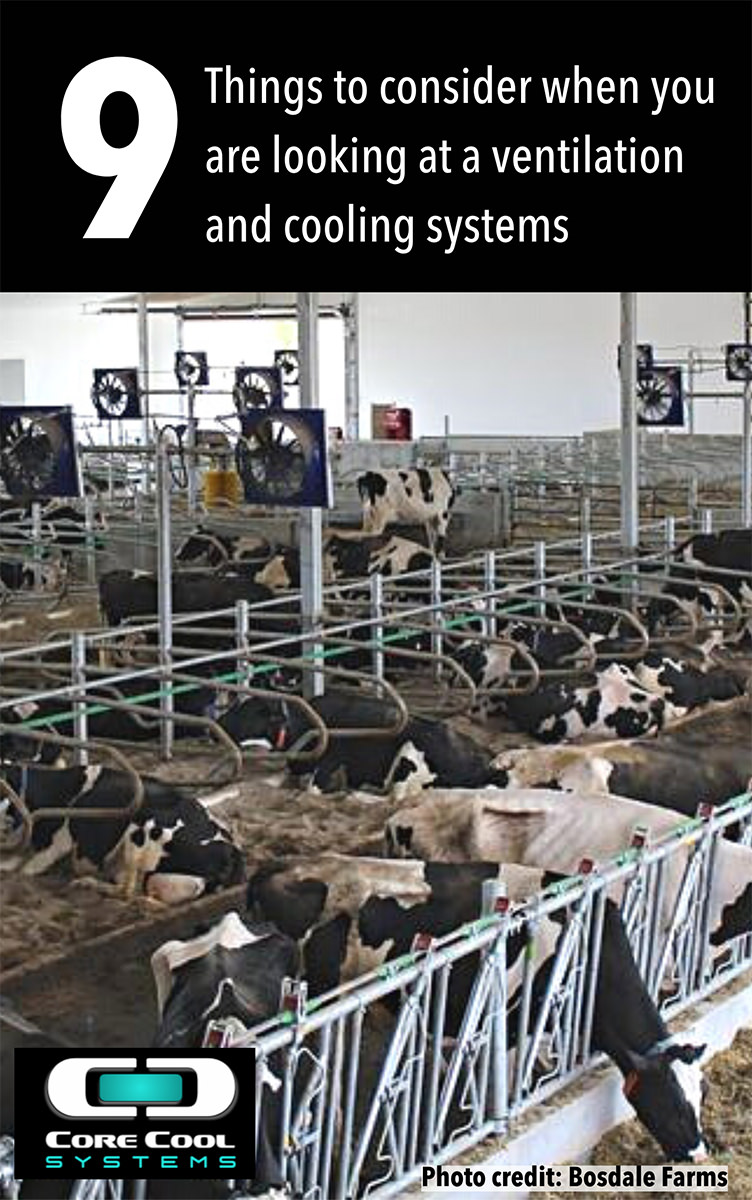Title search: ✖
|
Show All (51)
Cooling Cows (28) Cow Comfort (6) Dry Cow Cooling (1) Fall Lameness (2) FAQ's Answered (7) Metabolic Issues (2) Reproduction (2) Why Focus on Core Body Temperature (4)
FAQ - Why should I cool my dry cows? What impact does heat stress have on the cow, her next lactation, the calf in utero
Why is it important to keep cows' core body temperature cool, and how does Core Cool Systems achieve this?
Maximizing Dairy Herd Reproductive Health: Understanding the Impact of Heat Stress and Investing in Cooling Solution.
Are your summer electricity bills causing you to shudder? Maybe your barn fans are one of the biggest culprits.
Why is it important to clean your fans before summer? Are dirty fans costing you time, money and energy?
|
Heat stress effects linger months beyond summer.Written By: Suzanne Meck Think about your most stressful day. Now imagine that day lasts for several months. How productive would you be? How hard would you work? How much harder would you work if you weren’t stressed? That is exactly what your cows experienced with the hot summer temperatures. Daily stress impacts every aspect of your cows’ performance and ultimately dwindles your bottom line. But not only did you feel the consequences this summer, but many of the negative effects will also continue for months to come. Heat stress and production The most obvious result of heat stress is lost production. Milk production decreases for two reasons during high heat. First, cows reduce feed intake because eating and ruminating are high-heat-generating activities. When you are hot, you probably don’t want to eat very much either. By reducing its feed intake, the cow reduces the amount of heat it produces; however, less feed intake also means less milk output. The second reason milk production decreases during heat stress is that a stressed cow must use energy to reduce its stress load. Basically, it takes effort for a cow to stay cool. Even if the cow is maintaining feed intake, a portion of that feed is going to regulate its temperature rather than produce milk. Several feed additives can help maintain feed conversion during heat stress, but providing heat abatement systems is always the most important first step. The lag effect The real problem with a stress event is that not only are you losing production during the heat period, but you have also lost peak production you will never regain. If a cow is stressed during the climb toward peak production, that stress will prevent the cow from ever reaching its true peak. If a stressed cow is already at or past peak production, it will drop in production and never return to that level. Once the temperatures start to come down, it actually takes several months for production to rebound. Looking at an annual average production curve, you can see that milk production is finally returning to peak highs as temperatures start to rise again. Add into the equation that these stressed cows are also going through the fall feed change, and you have a recipe for disaster. The moral of the story: Reduce the cows’ stress load as much as possible. Herds with heat abatement often see less of a dip in summertime production and tend to recover more quickly. A vicious cycle Probably the next most obvious effect of heat stress is reduced conception rates. Most farms expect and sometimes plan for low summer conception. Poor conception means more days open and fewer productive days. Although poor pregnancy checks are expected through September and even October, the real impact on reproduction is felt the following spring. Cows that should be coming fresh in March or April are now freshening in June and July. Not only do those cows miss out on the ideal milk-producing temperatures, but they also are calving during higher heat stress and struggling to reach peak production during the warmest part of the year. The impact of heat stress on reproductive performance can quickly become a vicious cycle. Hidden impact A less obvious effect of heat stress is the impact on hoof health. When cows are hot, they spend more time standing in or away from their stalls. Standing increases their exposed body surface, which allows them to dissipate their heat more easily. If you have cooling at the feed bunk, cows will likely increase their time standing at the bunk – not eating, just trying to get cool. The ultimate scenario is to provide the ideal climate throughout the barn. By cooling in the stalls and at the feed bunk, cows are encouraged to rest, which helps reduce white-line disease and other hoof ailments that often result from standing too much. Another less-considered impact of heat stress is an increase in somatic cell counts. Several factors may contribute to the increase in somatic cell counts, including weakened immune function, higher bacterial survival/growth in warmer temperatures and more water, dirt and debris on the udder. Providing heat abatement and monitoring teat preparation procedures during milking can help keep somatic cell counts to a minimal level, despite the warm temperature. As you can see, heat stress is a problem that lasts long beyond the summer months. It is an issue that can impact nearly every important aspect of your herd’s health. Take action Heat stress impacts more than just milk production. When you start to evaluate the cost of all the effects of heat stress, it is easy to see that heat abatement is an investment that quickly pays. Keep in mind: Just because you feel comfortable does not mean your cows do. Reducing cows’ stress load means they are better equipped to work harder for you. Written By: Suzanne Merck P.S. Heat stress costs the North American dairy industry millions of dollars annually. You shouldn't have to deal with the heart-wrenching impact of heat stress on your cows and your operation. Core Cool Systems offers a solution to the damaging, long-lasting impact of heat stress. Proactively maintaining core body temperature to make every day feel like a cool day for your cows. Imagine being able to take temperature out of the equation. Investing in a Core Cool System can make that dream a reality. Share: https://www.corecoolsystems.com/blog/Blog18/Heat-stress-effects-linger-months-beyond-summer Share Category "Cow Comfort": |

